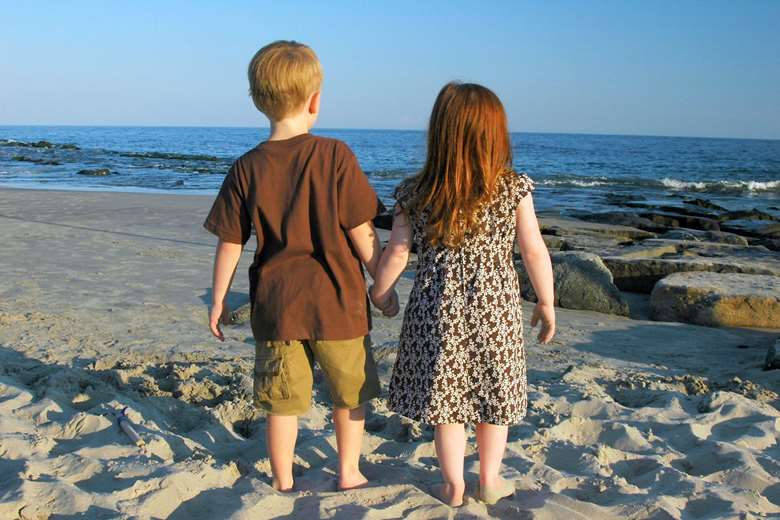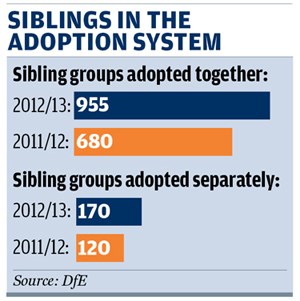Child's needs key to sibling adoption
Neil Puffett
Tuesday, March 18, 2014
When placing siblings for adoption, social workers must no longer assume they should be kept together.

Finding permanent homes for sibling groups in the care system has been a long-standing problem.
As part of ongoing reforms to the adoption system, the government is allowing social workers more flexibility to decide whether they place siblings together or separately.
So what impact will it have on practice and will it mean more siblings being placed apart?
The existing guidance states that siblings should be placed together "unless there is good reason why they should not be". This assumption is removed altogether in the proposed new guidance.
Instead, it states there should be a clear decision-making process to allow social workers to decide early whether it is in the best interests of each child to be placed together or separately, and the impact on each child of the decision.
Factors to be considered in reaching a decision on whether to place siblings together or separately should include whether they know each other, how they are related, whether they have formed an attachment, the health needs of each child and each child's view.
Child's best interests
Hugh Thornbery, chief executive of Adoption UK, says the guidance reflects the increasingly sophisticated decision making needed to assess whether to place children together.
"In many ways, given the loss experienced by children who are removed from their birth families to foster carers and adoption families, one can understand the real value of maintaining sibling groups," he says. "But we are at the point now where we understand it is not necessarily in their best interests.
"We are able to more effectively assess whether it is right to keep a group together and where it might be in the individual children's interests to split them up.
"The more we know about the outcomes of sibling groups, the more sophisticated we are getting at assessing need and early childhood trauma."
Government statistics show that, overall, the number of sibling groups adopted together and apart is rising.
Thornbery hopes that the rise in the number separated is due to better evidence-based decision making about what is in the child's best interests, rather than an unintended consequence of ongoing efforts to speed up the adoption process.
He adds: "The concern is that, knowing how difficult it is to place siblings, are we as a means of meeting expectations around timescales coming to a decision too quickly to split sibling groups?
"I'm not saying that is necessarily happening – but you can get unintended consequences of changes to the system."
Mark Owers, chief executive of the Consortium of Voluntary Adoption Agencies, says that while the changes will allow practitioners to consider the options more broadly, he doesn't believe the changes will result in a significant increase in the number of siblings being placed apart.
"I expect the changes to be more of a wake-up call to local authorities and voluntary adoption agencies to get better at adopter recruitment," he says.
"We know from the register that sibling groups and older children are over-represented. We haven't done enough to find adoptive families that want siblings. A greater focus is needed nationally on this rather than separating them and placing them singly."
Owers adds that if siblings are separated because adoptive families cannot be found, local authorities should think more creatively about the placements.
"If siblings are separated, it should be in the same community, so the siblings can maintain contact and the families can provide support for each other such as babysitting," he says. "If there are three or four children, it would be much more reasonable to expect two families to take them on.
"They can stay in contact with each other right from day one and there will be a ready-made support network that will help to keep the family together in a broader sense.
"There are very few families out there who are able to take on four children at the same time – particularly if they haven't had children before. It is going from a standing start to 100mph quickly."
Complicated decisions
John Simmonds, director of policy, research and development at the British Association for Adoption and Fostering, says there are two issues social workers will face in deciding whether to separate siblings.
The first, regardless of whether prospective adopters are available, is the "not straightforward" decision of whether separation would be in the best interests of the children based on their individual circumstances and experiences.
The second "more complicated" decision is, if it is deemed that the siblings should remain together but suitable adopters are not available, is it in the best interests of the children to separate them or wait?
"It is a huge responsibility to make that decision," Simmonds says. "Adoption teams and adoption panels are going to be significantly exercised by that question.
"We need to make sure the resources, training, support and access to information and advice is available when local authorities make those decisions, and there is some way to go on that.
"There is a relatively poor evidence-base and I don't have any doubt that it needs to be bolstered by investment to make sure local authorities have the skills and resources they need when faced by that difficult challenge."





